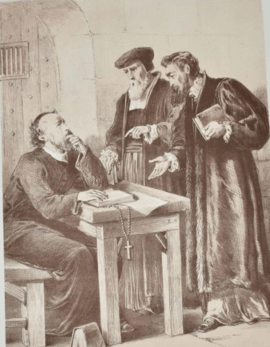George Napper facts for kids
Quick facts for kids BlessedGeorge Napper |
|
|---|---|

George Nappier, "They began to offer him some speeches". Illustration for Memoirs of Missionary Priests by Bishop Challoner (Jack, 1878).
|
|
| Martyr | |
| Born | c. 1550 Holywell manor, Oxford, England |
| Died | 9 November 1610 (aged 59 - 60) Oxford Castle, Oxfordshire, England |
| Beatified | 15 December 1929 by Pope Pius XI |
| Feast | 9 November (individual) 29 October (one of the Douai Martyrs) |
George Napper (also spelled Napier) was an English Roman Catholic priest. He was born around 1550 in Holywell manor, near Oxford, England. He died in Oxford on November 9, 1610.
George Napper is known as a Catholic martyr. This means he died for his religious beliefs. In 1929, he was declared "Blessed" by Pope Pius XI. This is an important step towards becoming a saint in the Catholic Church.
Contents
Life Story of George Napper
George Napper was the son of Edward Napper. His mother was Anne, whose uncle was Cardinal William Peto. George started studying at Corpus Christi College, Oxford in 1566. However, he was asked to leave in 1568. This was because he was a recusant. A recusant was someone who refused to attend the services of the Church of England.
In 1579, George visited the English College in Reims, France. This college was a place where English Catholics could train to become priests. By December 1580, he was put in prison in London. He stayed there until June 1589. He was released after he agreed to accept the royal supremacy. This meant accepting the King or Queen as the head of the Church in England.
In 1596, George Napper went to the English College, Douai. This was another important college for English Catholic priests. In 1603, he returned to England to serve as a priest. He likely lived with his brother William in Holywell.
Arrest and Trial
On July 19, 1610, George Napper was arrested. This happened early in the morning near Kirtlington, about four miles from Woodstock. When he was arrested, he had a pyx with him. A pyx is a small container used to hold consecrated Hosts (bread used in Catholic Mass). He also had a small reliquary, which holds a holy relic.
He was taken before a justice. They searched him carefully. However, they only found his breviary (a prayer book), his holy oils, and a small sewing kit.
The next day, he was sent to Oxford Castle. Soon after, he was charged with being a Catholic priest. This was against the law at the time, specifically the Jesuits, etc. Act 1584. The fact that he had holy oils was seen as proof that he was a priest. He was found guilty and sentenced to death. However, his execution was delayed.
While in prison, he helped a man named Falkner who was also sentenced to death. This was seen as making his own situation worse. Even so, people thought his death sentence might be changed to banishment. But George Napper refused to take the Oath of Allegiance. This oath would have meant he accepted King James I as the head of the Church. Because he refused, his death sentence was confirmed.
Execution and Burial
George Napper was executed on November 9, 1610. He had said Mass that morning. His head was placed on Tom Gateway, a famous gate in Oxford. His body was divided and placed on the four city gates. However, some parts of his body were secretly removed. They were buried in a chapel at Sandford manor. This place used to be a home for the Knights Templar.
Honors and Legacy
A special plaque was put up in his honor at Oxford Castle. This happened on October 23, 2010.
Blessed George Napier Roman Catholic School in Banbury is named after him. This school helps keep his memory alive.
See also
- Catholic Church in the United Kingdom
- Douai Martyrs

